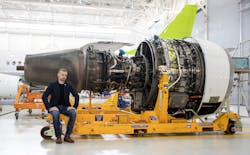The aircraft parts purchasing market is complex, filled with processes, constraints and management challenges both internally within airlines and MROs and with suppliers. Ensuring accountability, responsibility and transparency of the entire process is the core of modern compliance management, and even more so, to managing a successful SOX compliant organization.
SOX is in reference to the Sarbanes–Oxley Act, a law that the U.S. Congress passed to help protect investors from fraudulent financial reporting by corporations. It’s especially important for publicly traded airlines to adhere to these regulations. Unfortunately, the opaque and fragmented process or aircraft parts purchasing can make this difficult.
Despite modern tools found in adjacent industries and the growing world of eCommerce, the compliance question still remains, “am I getting the best deal and have we done all we can to do so?” It’s even more difficult to be able to look back and to answer the who/what/when/where easily, especially when the operation is moving at full speed.
Creating a More Transparent Supply Chain
These compliance obstacles are not only challenging, but also hinder the efficiency and profitability of airlines and MROs. “In order to combat these challenges, the aircraft parts supply chain needs a system that can easily answer any questions (who/what/when/where) about an aircraft material,” explained Erkki Brakmann, CEO of SkySelect “The purchaser should be assured that all the right suppliers were invited, can understand when and how challenges were solved and ensure that their organization is getting the best possible deals.”
The quickest way to compliance and transparency is by moving from a manual, paper-based system to a modern digital process. Even in 2021, far too much of the process and information of buying and selling aircraft material is done via paperwork, phone calls and fax machines. This his makes it extremely difficult to track and find back information critical to compliance.
The world of aircraft maintenance and parts procurement is so dynamic with needs, requirements and parts constantly moving and changing. So how can the industry possibly be successful while relying on so many static processes? There needs to be a new standard set for how the industry functions.
“We talk a lot about how automation and digitization saves time and makes airlines and MROs more efficient during the procurement process, but having the right digital tools can also pay huge dividends after the fact,” Brakmann noted. “When it comes time for administrative work such as audits, literally thousands of worker hours can be saved if all of the necessary information is neatly stored within a single system rather than having to sort through endless piles of paperwork, emails and files (both online and offline).
“The best part about a shift from offline to digital is that transparency will naturally improve,” Brakmann continued. “With everything being tracked and leaving a cyber trail behind, it becomes more difficult to lose information vital to compliance. To the fault of no employees, they’re simply following antiquated processes, just imagine how much information is simply lost because of the amount of activities happening offline.”
A great example to better paint this picture is the financial sector. Depending on where you live, nearly every transaction is carried out electronically in place of paper money changing hands. Not only has the created better budgetary understanding for the individual consumer, but it’s also made things such as money laundering a lot more difficult to execute. It’s the same for aircraft parts procurement. By having every item tracked and easily traceable, it creates a far more transparent environment, which leads to easier and better compliance, from which everyone benefits, from buyers and suppliers and government agencies, all the way down to the traveler.
About the Author

Erkki Brakmann
CEO
Erkki Brakmann is a supply chain professional and a technologist at heart. Throughout his career he has been working with various enterprise companies from automotive, manufacturing to aerospace industry. He has been leading supply chain transformation projects to automate and streamline processes. He's currently founder and CEO of SkySelect, which was established in 2017. Erkki and his team strive to make air transport leaner by building a world-class aircraft material supply chain using machine intelligence to automate the majority of the purchasing decisions.
